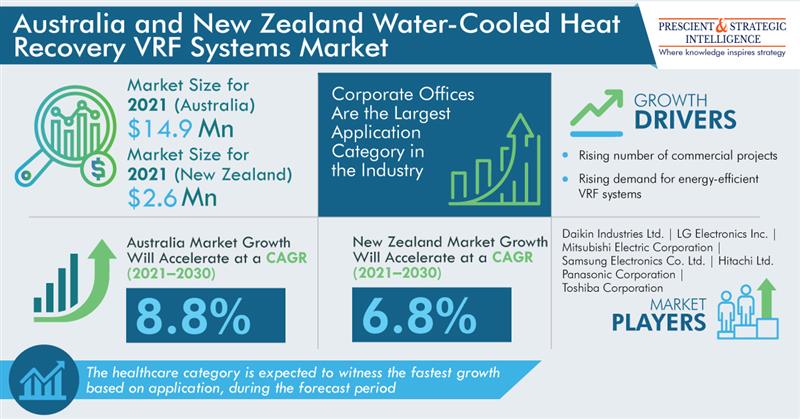The New Zealand water-cooled heat recovery VRF systems market will reach $4,677.2 thousand by 2030 from $2,590.8 thousand in 2021, at a 6.8% CAGR during 2021–2030. Similarly, the Australian water-cooled heat recovery VRF systems market is expected to generate $31,739.6 thousand revenue in 2030, growing from $14,881.0 thousand in 2021 at an 8.8% compound annual growth rate. VRF is a technology where an outdoor unit is connected to many indoor units, and the flow of the refrigerant is regulated to transfer heat from the spaces requiring cooling and cooling into spaces requiring heating.
There are two types of VRF systems: water-cooled and air-cooled. For using an air-cooled system, there has to be enough space for placing the condenser unit. Furthermore, the installation location must be able to sustain the weight of the systems, be free of windows, and be easily accessible for maintenance. Water-cooled systems are a good option if there is limited area, building heat capture and efficiency are sought, and a water loop is available. They can be designed to utilize the geothermal energy of lakes and rivers, or heat released during the cooling of computer servers and several other operations.
Get More Insights: Australia and New Zealand Water-Cooled Heat Recovery VRF Systems Market Segmentation Analysis Report
In the Australia and New Zealand water-cooled heat recovery VRF systems market, the category of healthcare is projected to grow at a significant rate in the near future. This is credited to the rising population and the increasing requirement for improving the healthcare facilities in New Zealand and Australia. As per the ABS, Australia’s population increased by 46,000 persons (0.2%) in June 2021 in comparison to June 2020. The requirement for medical and caregiving services is snowballing with the growing population, enabling an increase in the need for HVAC systems using the VRF technology in newly commissioned healthcare centers and as replacements at those that have existed for a while.
There are many benefits to choosing VRF systems, such as energy efficiency, compact size, flexibility, and silent operation. The system also can trap the heat as part of the cooling process and channel it to other areas of the building that might need heating. Moreover, with the use of these systems, energy savings of up to 55% are predicted over the traditional heating and cooling equipment, as it uses waste heat, rather than using electricity to generate the required amount.
Australia and New Zealand Water-Cooled Heat Recovery VRF Systems Market
The corporate offices category had the largest share in Australia and New Zealand water-cooled heat recovery VRF systems market in 2021, and it is predicted to dominate the market in the near future. This is credited to the expansion of the construction and infrastructure industries, itself on account of the increasing population of these countries. For example, in 2022, the Australian Industry and Skills Committee stated that the construction sector generated over $360 billion in sales, accounting for roughly 9% of the country’s GDP, which is expected to grow at a 2.4% rate in the coming years.
The major drivers in Australia and New Zealand water-cooled heat recovery VRF systems market are heat pumps in commercial applications, coupled with a dire need for effective VRF systems. In 2021, product sales in Australia valued at $14,881.0 thousand and at $2,590.8 thousand. Additionally, revenue growth in Australia will be an 8.8% CAGR, and in New Zealand, at 6.8% CAGR in the coming years respectively. At these rates, market players could make a combined $31,739.6 thousand and $4,677.2 thousand by 2030 in Australia and New Zealand, respectively.
The surging population levels will spur the Australia and New Zealand water-cooled heat recovery VRF systems market growth. Thus, this will pave the way for the real estate industry’s expansion. Moreover, this will go hand in hand with the increasing number of construction activities in these two countries. Furthermore, there was a 6.2% and 0.4% escalation in the count of dwellings approved in New Zealand and Australia, respectively, during 2017–2021. Also, these magnificent figures show the enormous growth in the construction and real estate sectors of these two countries.
Water-Cooled Heat Recovery VRF Systems Market in Australia and New Zealand is Driven by Commercial Sector
According to the market research report published by P&S Intelligence, Australian water-cooled heat recovery VRF market value is set to reach $31,739.6 thousand by 2030, at an 8.8% CAGR. Similarly, the New Zealand water-cooled heat recovery VRF market revenue, which was estimated at $2,590.8 thousand for 2021, will experience a CAGR of 6.8%, to reach $4,677.2 thousand by 2030. This presents lucrative opportunities for electrical appliance companies, such as Daikin Industries Ltd., LG Electronics Inc., Mitsubishi Electric Corporation, Samsung Electronics Co. Ltd., Toshiba Corporation, Panasonic Corporation, and Hitachi Ltd.
In the coming years, infrastructure development is expected to pick up rapidly in the urban areas of the country, perhaps with tight deadlines to complete projects that were delayed due to the COVID-19 pandemic. This also means that the key Australia and New Zealand water-cooled heat recovery VRF market players would promote their products even more aggressively, to make up for the massive loss of revenue due to the shutting down of industrial and commercial facilities in 2020 and during a significant portion of 2021.
Key Findings of Australia and New Zealand Water-Cooled Heat Recovery VRF Market Report
- Another key reason driving the sale of such equipment in Australasia is the growing focus on green buildings. Since VRF systems act as a complete HVAC solution, they eliminate the need for different systems for heating, ventilation, and air conditioning, thus saving energy.
- In this regard, a key driver for the Australia and New Zealand water-cooled heat recovery VRF market is the New Zealand Building Council’s target to construct only 100% green buildings from 2030 onwards.
- Similarly, the Green Building Council of Australia has set this target for 2050, which will ultimately push up the requirement for VRF systems, especially in its major urban centers, such as Melbourne, Sydney, Adelaide, Hobart, Darwin, Perth, and Brisbane.
- Hence, the rapid infrastructure development in these countries is the major driver for water-cooled heat recovery VRF system sales here. For instance, in 2021 Q2, the value of the construction done in Australia rose to $36,415.4 million (AUD 52,875.5 million).
- Among all the components of such systems, outdoor units witness the highest installation rate, due to the rising integration of inverter-controlled compressors as a means to save energy.
- In the coming years, the sale of indoor units is set to increase the fastest in both the countries, as multiple indoor units are connected to one outdoor unit in a building.
The healthcare category will become a major revenue contributor to the Australia and New Zealand water-cooled heat recovery VRF market in the coming years owing to the government measures to advance their healthcare infrastructure. For instance, the Government of New Zealand has announced an investment of $500.9 million (NZD 700 million) for healthcare infrastructure development and plans to renovate 24 local hospitals in the coming years.
Browse detailed report on Australia and New Zealand Water-Cooled Heat Recovery VRF Systems Market Growth Prospects, and Demand Forecast Through 2030
Similarly, many new hospitals are being constructed in Southern Australia and several older ones renovated. This will lead to a high sale of water-cooled heat recovery VRF systems for newer infrastructure as well as to replace the conventional HVAC systems installed in existing spaces. The preference for VRF systems is driven by their energy-saving feature, which is due to the capturing of the waste heat from the areas being cooled and its usage in areas that need to be heated.
How did the Outbreak of COVID-19 Impact the Australia and New Zealand Water-Cooled Heat Recovery VRF Systems Market?
The extensive government support will create lucrative opportunities for the Australia and New Zealand water-cooled heat recovery VRF systems market players assisting them to adapt to the existing dynamics of the circular economy. This is accompanied by a rising inclination toward green buildings. Furthermore, this will result in skyrocketing demand for VRF systems in these countries because it is an all-in-one device: providing complete air conditioning, ventilation, and heating solutions for the building. New Zealand aims for completely carbon-free newly constructed buildings by 2030.
The outbreak of COVID-19 had ruptured the entire circular economy, and the Australia and New Zealand water-cooled heat recovery VRF systems market was not an exception. It reduced the manufacturing activities, lowering the water-cooled heat recovery VRF systems requirement. In 2020, there was a 1.4% and 2.2% decline in the manufacturing industries of New Zealand and Australia respectively. Moreover, the pandemic significantly increased the unemployment rates, lowering the disposable income, and consequently reducing the purchasing power of consumers. Resultingly, corporations witnessed huge losses due to declining sales and piling up the inventory.
New Zealand Water-Cooled Heat Recovery VRF Systems Market
Furthermore, lockdowns were imposed in several economies to curb the spread of the virus. This led to the temporary shutdown of commercial offices and buildings. Additionally, there was a rising inclination toward the work-from-home culture by numerous corporations, which gradually ruptured the requirement for office spaces. Nonetheless, the Australia and New Zealand water-cooled heat recovery VRF systems market is recovering significantly, increasing the office occupancy rates because of the transmission risk aversion and reducing social restrictions.
Within the application segment, the healthcare category will exhibit the swiftest growth in the coming years. This can be credited to the growing geriatric population, rising incidence of chronic illnesses, surging disposable income, and enhancing healthcare infrastructure in these countries. Therefore, the robust growth in the market is due to the development of clinics and hospitals to meet the demands of the skyrocketing population levels. A key aspect of medical care is making patients comfortable, which pushes the requirement for appropriate HVAC systems. Hence, the sale of water-cooled heat recovery VRF systems is increasing due to the growing need for energy-efficiency systems.












Add Comment